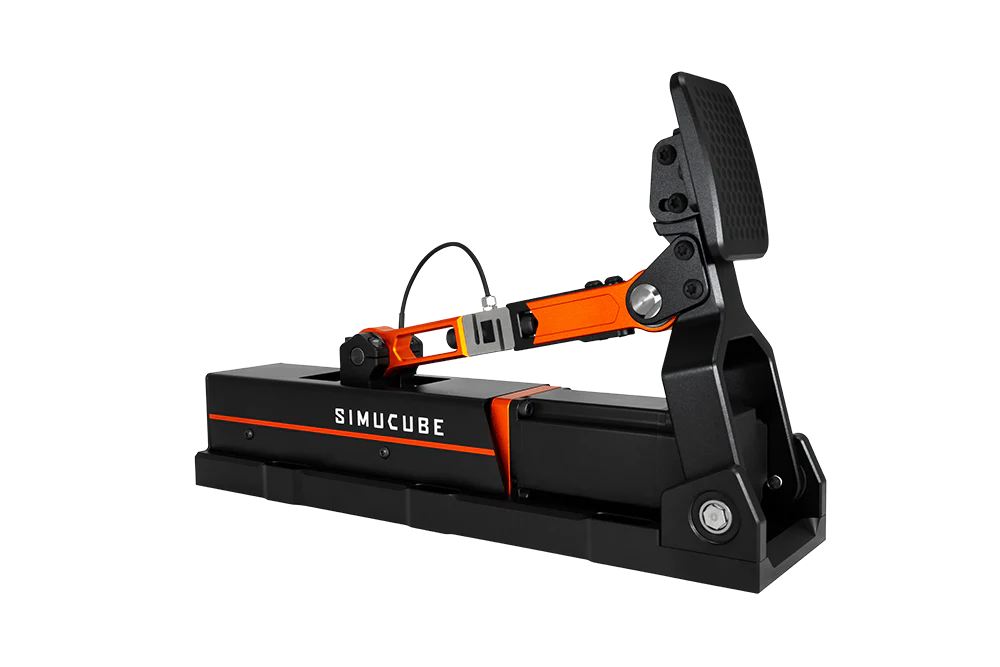After a steering wheel, I’d say that pedals are the single most important peripheral for an immersive sim racing experience. That’s why I’d advise you to spend a fair bit of time researching the different options on the market and find the very best set of pedals you can.
Below you will find a guide where I’ll go over everything you need to know about sim pedals. We’ll talk about how they work and what that means for you in the sim, but before we do, here’s what I consider the best pedals at every level:
Best Sim Racing Pedals 2024
| Editors Pick | Pedal |
|---|---|
| Top Pick | Heusinkveld Ultimate+ |
| Runner-up | Fanatec Clubsport V3 |
| Also great | Thrustmaster T248 |
| Budget | Fanatec CSL Elite LC |
| Luxury | Simucube Active Pedals |
Top pick
Heusinkveld Sim Pedals Ultimate+
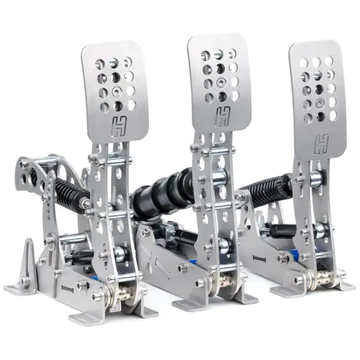 Heusinkveld Sim Pedals Ultimate+ - Digital-Motorsports.com
Heusinkveld Sim Pedals Ultimate+ - Digital-Motorsports.com
For the uncompromising sim racers out there
The Heusinkveld Sim Pedals Ultimate+ are every bit as epic as their name suggests, having been designed specifically to be used in the most demanding environments in order to simulate the pedal forces as experienced in F1 and GT cars.
Heusinkveld Engineering have made this pedal set from CNC precision laser-cut stainless steel in order to ensure flawless performance for decades to come, then blasted the raw steel with glass beads to give the set a high quality semi-gloss metallic look with a minimum of sharp edges. Aesthetic details are just the beginning though; this pedal set is built to be the workhorse of your racing rig.
Each of the three pedals has its very own load cell for unrivaled tactility, and each arm has an adjustable hydraulic pedal damper so that you can adjust resistance to suit your needs. Each of the pedals can be independently adjusted in a positively exhaustive number of ways to ensure that no fractions of seconds will be lost because of anything other than user error.
Each pedal set comes with a USB controller box that serves as a load cell amplifier and allows for the connection of additional peripherals and accessories. Sadly, the Heusinkveld Sim Pedals Ultimate+ is only compatible with PC.
Runner-up
The Fanatec ClubSport V3 pedals are arguably the best bang for your buck of any set on the market. Fanatec checks all of the boxes with this set and its full metal (CNC machined aluminum) construction is sturdy and sleek. While the red-on-black finish will be the first thing about the ClubSport V3 to catch your eye, it’s what’s under the hood that really counts.
The V3 throttle and clutch use contactless Hall Effect sensors, and the brake uses a best in class 90kg load cell. Adjustability is through the roof on this set – the position of pedal plates in all directions, their angles, spring force, brake pressure sensitivity, and brake travel are all tweakable right out of the box. There are also a pair of optional kits available for purchase if you want to customize the set further – a hydraulic damper kit for the throttle pedal and a brake performance kit to perfect the resistance of your load cell pedal.
Fanatec takes things to another level with vibration feedback on the throttle and brake as well, which simulate advanced effects such as oversteer and ABS when in supported sims. The ClubSport V3 pedals are ready to go on PC right out of the box, even with non-Fanatec wheel bases thanks to the included USB adapter; this set is also compatible with Xbox and PlayStation consoles, but only when connected to a console-specific Fanatec wheel base.
One final note: Fanatec also offers the ClubSport V3 in an inverted “GT style” configuration at a higher price. Top it all off with a two-year warranty, and you have a pedal set that can suit the needs of all but the most hardcore of sim racing enthusiasts.
Also great
The Thrustmaster T-LCM is a great pedal set whose price belies a solid construction and great feature set. The most surprising fact about this set is that “LCM” stands for Load Cell and Magnetics (Hall effect sensors) which you wouldn’t typically expect to see in this price range.
Also surprising given the price tag is that this set is constructed of all metal. So where have Thrustmaster cut costs? The only real downside of this set is the dramatically decreased adjustability options.
Thrustmaster does offer adjustability where it really counts – a set of six springs are included for the brake pedal to adjust travel and resistance, each pedal’s spacing is independently adjustable, and an optional mount can be purchased for inverted “GT style” racing – but I’d love to see more than three positions for each arm and more adjustability of the throttle and clutch.
All said, there really is a lot to love about the Thrustmaster T-LCM pedal set, and it’s especially easy to recommend to anyone who already has a Thrustmaster wheel base. Note that this set is fully compatible with PC, and works with Xbox and PlayStation consoles when paired with a handful of compatible Thrustmaster wheel bases.
Budget
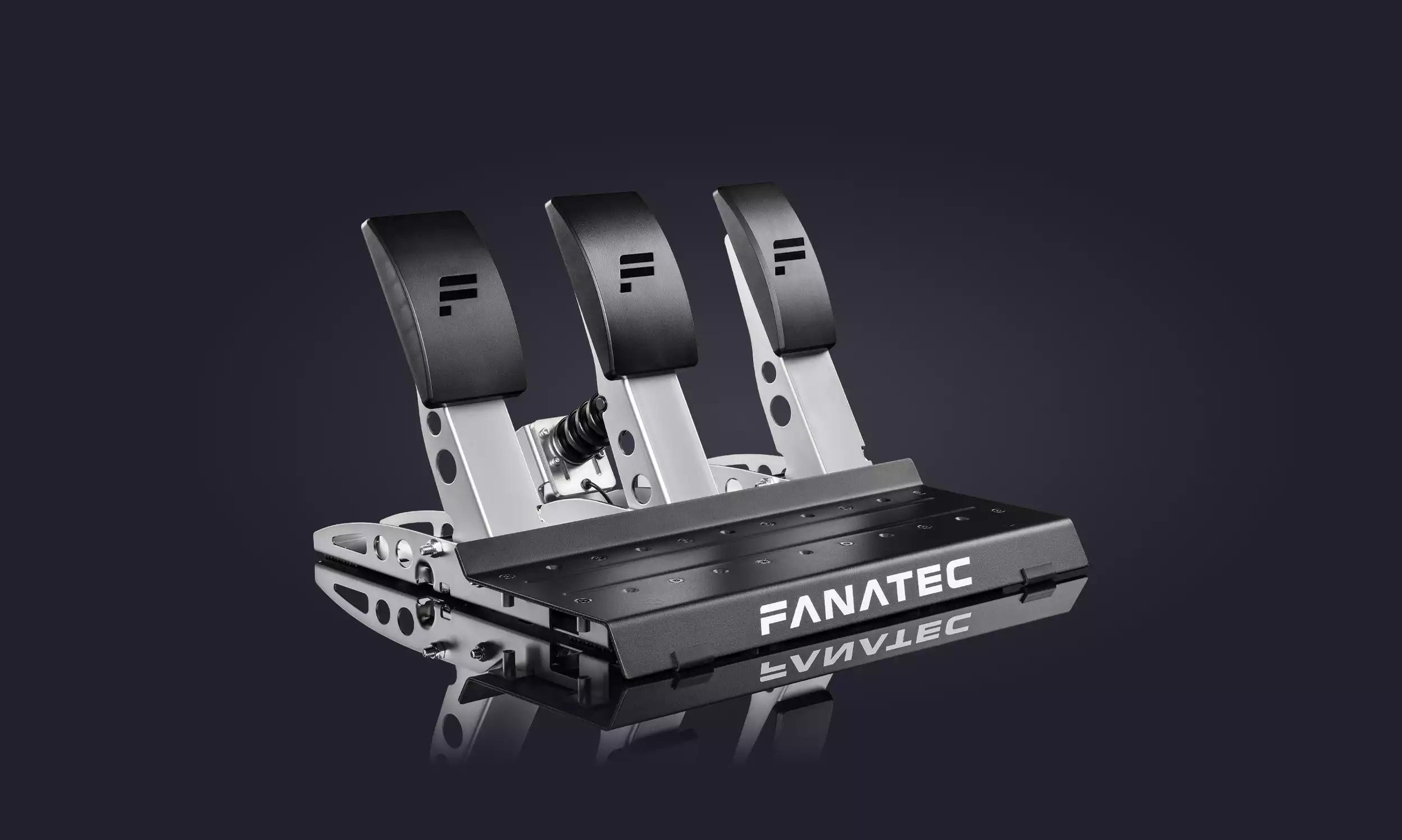 CSL Pedals LC | Fanatec
CSL Pedals LC | Fanatec
This awesome pedal set is highly customizable and features a load cell in the brake
The CSL Elite LC has a full aluminum construction with a handsome black finish, a great 90kg load cell brake pedal, and fantastic adjustability features. It’s compatible with PC and console, and an additional thoughtful consideration is here in the form of a dedicated USB controller and port for a Fanatec sim racing handbrake so that you can pass it through the heel rest instead of plugging directly into your sim machine of choice.
Speaking of that heel rest, it can be fully removed from the pedals so that they can be independently installed in your cockpit of choice or custom floor mount assembly. The only pieces of negative information here are the decreased adjustability and lack of Hall effect sensors in the clutch and throttle.
Luxury
If you’ve got sleek pedals at your feet, packed with force feedback, G-force, ABS, and RPM features that make every move feel like the real deal, you have Simucube Active Pedals. These pedals have a solid and sturdy build that’s ready to handle all the action you can throw at them.
Simucube Active Pedals are fully motorized, giving you complete control over the pedal force with their motorized actuator and control algorithms. This means you can customize the brake pressure all the way up to 150kg, giving you a super realistic and totally customizable brake feel. Plus, with connectors like Simucube Link, two external passive pedal ports, power in, and power out, these pedals are ready to integrate seamlessly into your setup without any fuss. They’re engineered to work like a dream with a range of sim racing games, so you can immerse yourself in the action without missing a beat.
With a 24-month warranty and a robust build that’s all about delivering that authentic racing experience, the Simucube Active Pedals are definitely the gear to take your virtual racing adventures to the next level. The price tag per pedal will keep this as a luxury dream item for many daily racers.
A Brief Guide to Sim Racing Pedals
Now that you have an idea of some of my choices, let’s start with a quick overview of how pedals work and the different types.
So obviously, the main job of a sim racing pedal is to convert the physical input you apply to the pedal into a digital signal which your computer or console (and as a result the sim itself) can understand.
Now there are three main technologies used to do this: potentiometers, Hall effect sensors, and load cells. There’s also a fourth category which we’ll discuss – hydraulic – although it’s only really used in professional-grade racing pedals.
Avoid the most inexpensive pedal sets that just include a brake and accelerator. Instead, go for ones that allow you to have a real manual driving feel without the need for upgrades. They come loaded with awesome features like load cells, Hall effect sensors, metal build, and tons of customization options. These pedals are built to give you a driving experience that feels exactly like actually driving a car, and no costs are cut to achieve this level of realism.
Potentiometer Pedals
Potentiometers are simple electrical devices that convert physical inputs into digital signals. There are different types of potentiometer but most sim racing pedals use rotary potentiometers, which product a stronger signal the further they are rotated.
Here’s a photo of the throttle pedal in a Logitech set:
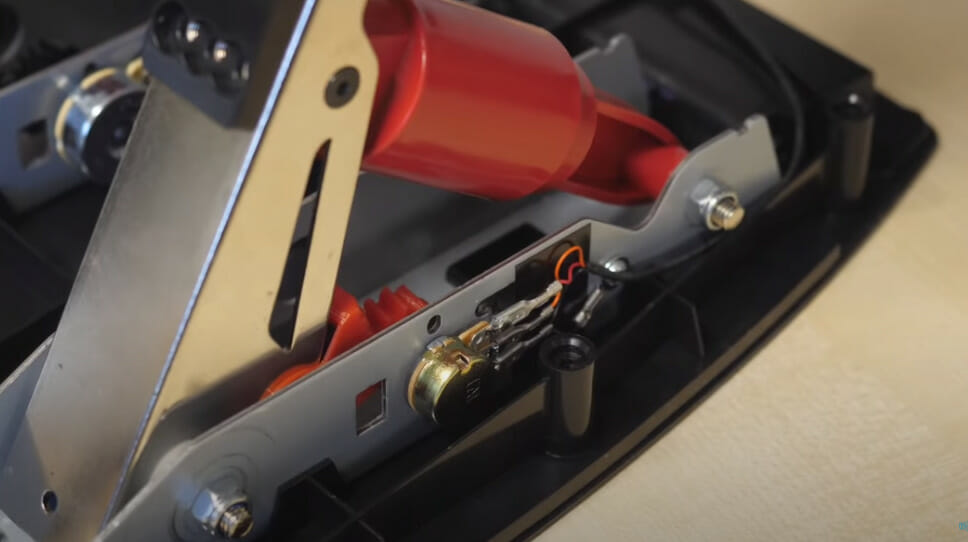
The circular, gold piece in the bottom center of the photo is the potentiometer. As you push down on the pedal, the red cog behind the potentiometer rotates and the potentiometer detects by how much.
Potentiometers are usually found in beginner sim racing pedals. There’s nothing wrong with them – after all, they’re used in all sorts of peripherals (including most PC joysticks) – but they’re not as reliable or realistic as other sensors.
One reason for this is that potentiometers can only measure distance. They measure how far you push the pedal, but not how hard you push. This is fine for the throttle and clutch, but feels unrealistic for the brake pedal, where force matters in a real car.
Hall Effect Pedals
Hall effect sensors produce a similar result to potentiometers while benefiting from a few additional advantages. Just like potentiometers, they measure the travel in a pedal and convert it to a digital signal.
Where Hall effect sensors diverge is in the way that pedal travel is measured – via magnets. Whereas potentiometers rely on friction, Hall effect sensors measure distance using electromagnetism.
Here’s a photo of what’s underneath the throttle of Thrustmaster’s T-LCM pedal set:
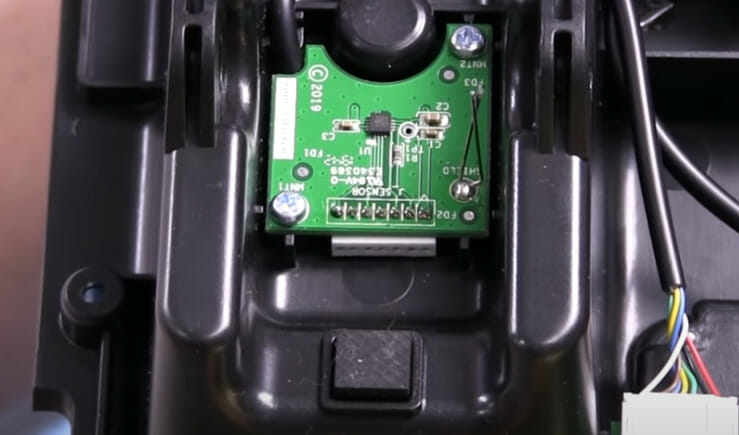
That green chip is the Hall effect sensor. The throttle pedal itself (not pictured) has a magnet on it which activates the sensor as you push down.
Again, there’s no friction involved, so compared to potentiometers, the Hall effect approach is more reliable and more durable. However, as you might expect, these sensors are harder to engineer, which translates to more expensive pedals.
Nevertheless, they share the same issue as potentiometers: they only measure distance. As a result, they’re still not quite good enough for realistic brake pedals.
Load Cell Pedals
Load cells are the final type of input sensor used in sim racing pedals. They’re different from potentiometers and Hall effect sensors in that they measure force instead of distance. In other words, they measure how hard you push, and not how far you push.
Here’s what the load cell looks like behind the brake pedal of the Fanatec CSL Elite LC:

Without a doubt, load cells are the hottest and most-hyped of the three input sensor types used in sim racing pedals. They’re primarily used for brake pedals, but they’re just so much more realistic, because force is all that counts when breaking in a real-life car.
The elephant in the room here is that load cell sensors are considerably more expensive, which translates to massive price jumps in products that include them. With that said, I definitely recommend that sim racers who can fit load cell pedals in their budget do so.
Hydraulic Pedals
There’s one other technology that you might see used in professional-grade sim racing pedals, and that’s hydraulics.
I’m not an engineer, but to my understanding, the basic idea of hydraulic systems is that you store fluid inside pressurized cylinders. When you apply force to one of them, fluid flows into the others causing them to exert force elsewhere.
This is how the braking systems in most real-life cars work. You push down on the brake pedal from inside the car, which causes fluid to flow towards the brake calipers, and squeeze against the rotors.
In hydraulic sim racing pedals, it works a little differently. When you push down on the pedal, pressure inside the system increases. A pressure sensor measures the increase in pressure and converts it into a digital signal.
You know you’re dealing with hydraulic pedals when you see little chambers of fluid mounted to the back of the assembly:
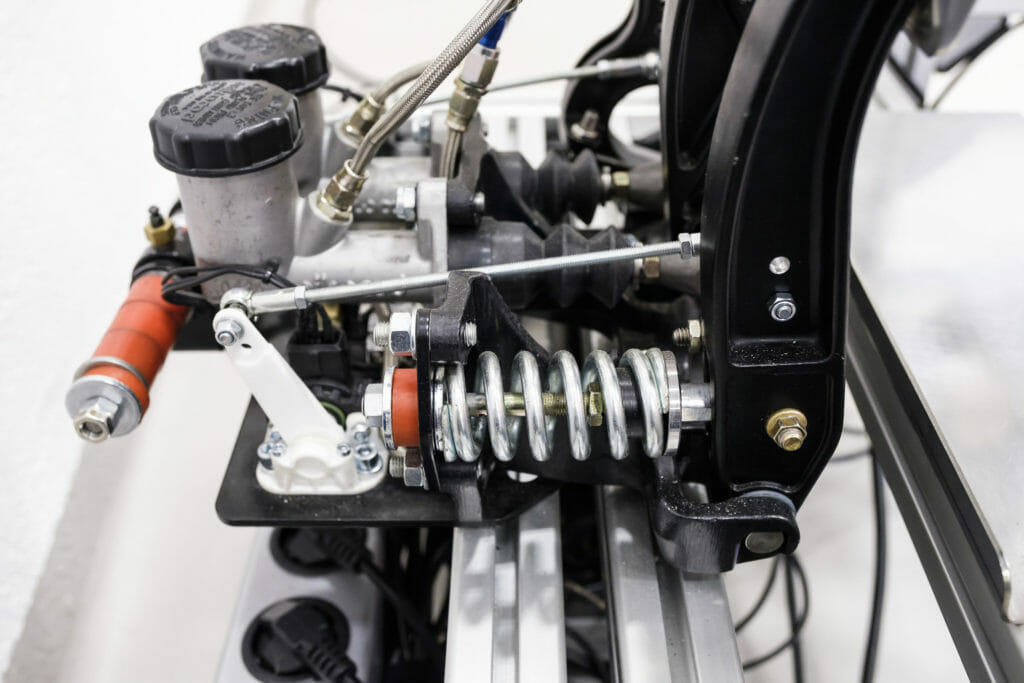
It’s up to you
Picking the top sim racing pedals can be tricky, but every option has its own special feature. In the end, it’s all about what you like and your style of racing. So, make a smart choice and prepare to enhance your digital driving experience!
Last Updated on March 14, 2024



